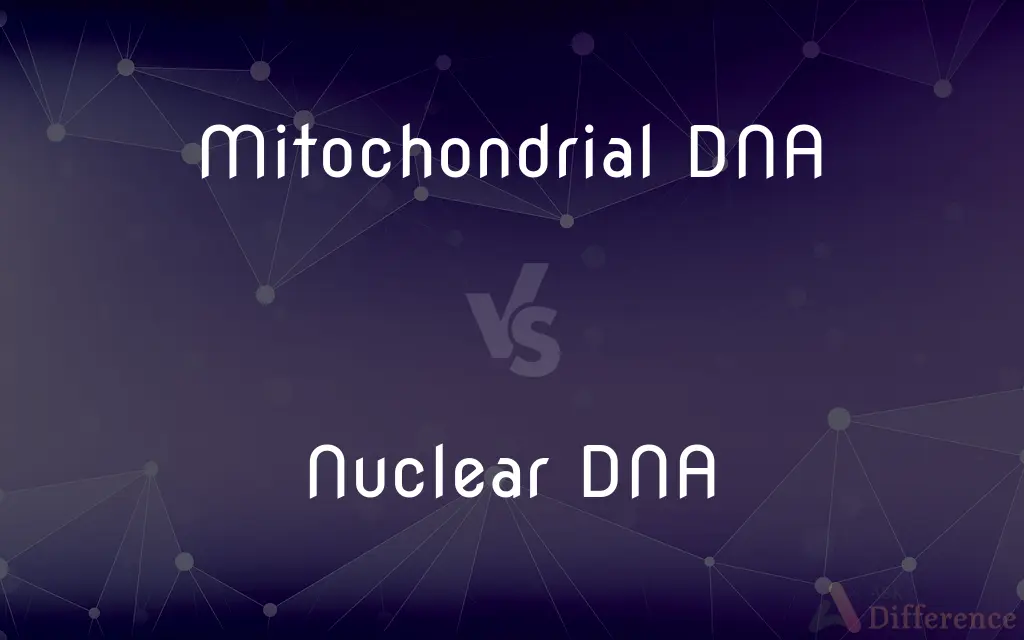Mitochondrial DNA vs. Nuclear DNA — What's the Difference?
By Tayyaba Rehman — Published on January 10, 2024
Mitochondrial DNA is small, circular DNA in mitochondria, inherited maternally. Nuclear DNA is complex, linear DNA in the nucleus, inherited from both parents.

Difference Between Mitochondrial DNA and Nuclear DNA
Table of Contents
ADVERTISEMENT
Key Differences
Mitochondrial DNA (mtDNA) is found in the mitochondria, the energy-producing organelles of cells. It is a small, circular DNA molecule, usually consisting of about 16,000 base pairs. Mitochondrial DNA is inherited exclusively from the mother, following a matrilineal inheritance pattern. It encodes for genes essential for mitochondrial function, primarily involved in cellular respiration and energy production.
Nuclear DNA, on the other hand, is located in the cell nucleus and is vastly more complex than mitochondrial DNA. It is composed of linear chromosomes, with the human genome comprising approximately 3 billion base pairs. Nuclear DNA is inherited from both parents, with each parent contributing half of the nuclear DNA to their offspring. This DNA contains the vast majority of genetic information, including genes that determine individual characteristics and play roles in almost all cellular functions.
Mitochondrial DNA is known for its high mutation rate compared to nuclear DNA. These mutations can be used to trace maternal lineage and are significant in studies of human evolution and population genetics. Despite its small size, mutations in mtDNA can lead to a variety of mitochondrial diseases due to its critical role in energy production.
Nuclear DNA is responsible for encoding most of the genetic information and is crucial for the development and functioning of organisms. It is protected by complex chromatin structures and undergoes recombination during sexual reproduction, contributing to genetic diversity. Mutations in nuclear DNA can lead to a wide range of genetic disorders and are the basis of heredity and variation among individuals.
In summary, mitochondrial DNA and nuclear DNA differ in their location, size, inheritance patterns, and functions within the cell. While mtDNA is crucial for mitochondrial function and maternal lineage tracing, nuclear DNA contains the majority of genetic information and determines most characteristics of an organism.
ADVERTISEMENT
Comparison Chart
Location
Mitochondria
Cell nucleus
Structure
Circular
Linear chromosomes
Size
~16,000 base pairs
~3 billion base pairs
Inheritance
Maternal
Both parents
Function
Energy production, mitochondrial function
Encodes most genetic information, determines individual characteristics
Compare with Definitions
Mitochondrial DNA
Mitochondrial DNA mutations can lead to mitochondrial diseases.
A mutation in the patient's mitochondrial DNA was responsible for the disorder.
Nuclear DNA
Nuclear DNA encodes most of the genetic information of an organism.
Scientists focused on nuclear DNA to understand the genetic basis of the disease.
Mitochondrial DNA
Mitochondrial DNA is essential for cellular respiration and energy production.
The role of mitochondrial DNA in energy production is crucial for cell function.
Nuclear DNA
Nuclear DNA is the complex, linear DNA located in the cell nucleus.
Genetic testing analyzed the individual's nuclear DNA for mutations.
Mitochondrial DNA
Mitochondrial DNA is inherited exclusively from the mother.
The child's mitochondrial DNA matched that of the mother, as expected.
Nuclear DNA
Nuclear DNA undergoes recombination, crucial for heredity and evolution.
Recombination in nuclear DNA during reproduction leads to genetic variation.
Mitochondrial DNA
Mitochondrial DNA has a high mutation rate useful for evolutionary studies.
Researchers used mitochondrial DNA mutations to trace human evolutionary history.
Nuclear DNA
Nuclear DNA is inherited from both parents, contributing to genetic diversity.
The child's nuclear DNA was a combination of both parents' genetic material.
Mitochondrial DNA
Mitochondrial DNA is the small, circular DNA found in mitochondria.
Scientists studied mitochondrial DNA to understand maternal ancestry.
Nuclear DNA
Mutations in nuclear DNA can lead to a wide range of genetic disorders.
A mutation in the nuclear DNA was identified as the cause of the inherited condition.
Common Curiosities
What does mitochondrial DNA encode?
Mitochondrial DNA encodes genes essential for mitochondrial function and energy production.
How is mitochondrial DNA inherited?
Mitochondrial DNA is inherited maternally, passed down from the mother.
How is nuclear DNA inherited?
Nuclear DNA is inherited from both parents, with each contributing half.
Can nuclear DNA mutations affect health?
Yes, mutations in nuclear DNA can lead to a wide range of genetic disorders.
What is nuclear DNA?
Nuclear DNA is the complex, linear DNA located in the cell nucleus.
Is mitochondrial DNA useful in ancestry studies?
Yes, mitochondrial DNA is used to trace maternal lineage and study human evolution.
Does nuclear DNA play a role in genetic diversity?
Yes, recombination in nuclear DNA during reproduction contributes to genetic diversity.
Are there any protective structures for nuclear DNA?
Yes, nuclear DNA is protected by chromatin structures in the nucleus.
What is mitochondrial DNA?
Mitochondrial DNA is the small, circular DNA found in mitochondria.
What does nuclear DNA encode?
Nuclear DNA encodes most of the genetic information, including genes for individual characteristics.
Can mitochondrial DNA be used in forensic science?
Yes, mitochondrial DNA is sometimes used in forensic science for maternal lineage identification.
Can mitochondrial DNA mutations affect health?
Yes, mutations in mitochondrial DNA can lead to mitochondrial diseases.
Is nuclear DNA the same in all cells of an organism?
Yes, nuclear DNA is generally the same in all cells of an organism, except for gametes and some exceptions.
How large is mitochondrial DNA?
Mitochondrial DNA is relatively small, with about 16,000 base pairs.
How large is nuclear DNA?
Nuclear DNA is much larger, with about 3 billion base pairs in humans.
Share Your Discovery

Previous Comparison
Certificate Holder vs. Additionally Insured
Next Comparison
CGI vs. ServletAuthor Spotlight
Written by
Tayyaba RehmanTayyaba Rehman is a distinguished writer, currently serving as a primary contributor to askdifference.com. As a researcher in semantics and etymology, Tayyaba's passion for the complexity of languages and their distinctions has found a perfect home on the platform. Tayyaba delves into the intricacies of language, distinguishing between commonly confused words and phrases, thereby providing clarity for readers worldwide.












































